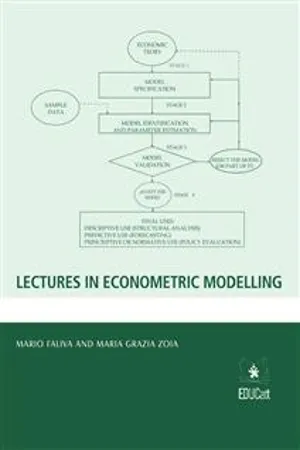
Lectures in econometric modelling (ed. 2015)
- English
- ePUB (mobile friendly)
- Available on iOS & Android
Lectures in econometric modelling (ed. 2015)
About this book
This book collects a series of lectures on classical econometrics given, at different times, at the Catholic University of Milan and at the Geneva University, on the one hand, as well as within several PhD. programs in Economics and Statistics, on the other.
As prerequisites to successfully tackle the topics dealt with in the book, we recommend the usual toolkit of linear algebra and mathematical statistics, beyond a knowledge of the principles of econometrics.
The book is essentially meant to provide a thorough overview on the theory and methods of multi-equation econometric models.
The topics to be investigated move from a conspectus of forms of both linear and non-linear models, in static and dynamic frameworks, to causal structure analysis from a system-theoretic standpoint, to continue with parameter identification and estimation issues, and simulation and prediction techniques, to conclude with multiplier analysis and policy utilization of econometric models.
A useful insight into the book design and intents can be gained by looking at the table of contents in the light of the flow-diagram shown in the front cover.
Milan, February, 2014
Mario Faliva – Maria Grazia Zoia
Frequently asked questions
- Essential is ideal for learners and professionals who enjoy exploring a wide range of subjects. Access the Essential Library with 800,000+ trusted titles and best-sellers across business, personal growth, and the humanities. Includes unlimited reading time and Standard Read Aloud voice.
- Complete: Perfect for advanced learners and researchers needing full, unrestricted access. Unlock 1.4M+ books across hundreds of subjects, including academic and specialized titles. The Complete Plan also includes advanced features like Premium Read Aloud and Research Assistant.
Please note we cannot support devices running on iOS 13 and Android 7 or earlier. Learn more about using the app.
Information
CHAPTER 1
Formal Aspects of Econometric Models
1. Econometric Model Building Activities

2. The Structural Form
Table of contents
- INDICE
- Preface
- CHAPTER 1 Formal Aspects of Econometric Models
- CHAPTER 2 Causal and Interdependent Systems
- CHAPTER 3 From the Model to the Structure
- CHAPTER 4 The Model Validation
- CHAPTER 5 Econometric Prediction
- CHAPTER 6 The Use of Econometric Models for Policy Evaluations
- ADDENDUM An Approach to Linear Dynamic Models Bridging Classical and Time-Series Econometrics
- INDICE
- References